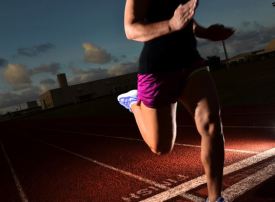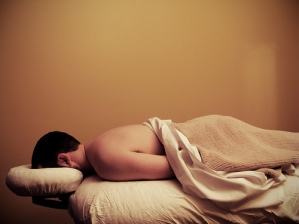By Carla Cranbury, PT
Let’s face it, we sit a lot. Between working, commuting, and watching television, the Canada Health Measures Survey found that most Canadian adults spend 9 hours and 48 minutes of their waking time being sedentary. Most of us know that physical activity is good for us, but did you know that just sitting less (regardless of exercise) can also be beneficial in the long term?
A study published in 2009 followed more than 17 000 Canadians for 12 years. Over the twelve years they compared the participants’ daily sitting time and leisure time physical activity with mortality rates of various causes. What they found was that the amount of daily sitting time was positively associated with mortality rates from all causes, except cancer. Basically the more people sit, the higher the risk of mortality. This even includes people who are physically active, showing that high amounts of sitting time cannot be compensated for with exercise, even if it exceeds the current minimum physical activity recommendations.
Other studies have echoed similar findings. A seven year study reported that people who spend less than half their time sitting have a lower risk of mortality than those who spend more than half their day sitting. Another six year study reported that women who spend 16+ hours sitting per day have an elevated risk for cardiovascular disease compared with women who sit for less than 4 hours a day.
These studies are not to say that physical activity is not important – it still is, and it is still beneficial for your health. Physical activity also contributes to decreased time spent sitting. What these studies are saying is the physiology associated with excessive sitting is different than the physiological benefits of exercise, and therefore excessive sitting cannot be compensated for with periods of exercise.
So now that you know, what can you do?
If you work at a desk most of the day, sitting can be hard to avoid. Some options are:
- Ask your work if they can accommodate an ergonomically sound standing desk
- Take frequent breaks from sitting to walk around
- Go for a walk on your lunch break
- Walk to your co-workers desk to talk to them instead of sending an email
- Park at the back of the parking lot to get a few extra steps
- Take the stairs!
- Take frequent standing breaks throughout the day
- Discover new ways to be active during your leisure time – ditch the TV and get outside
It’s the small changes to your daily routine that can add up and make a big difference. The best time to start is today!
References
Katzmarzyk, Peter T. et al. “Sitting Time And Mortality From All Causes, Cardiovascular Disease, And Cancer”. Medicine & Science in Sports & Exercise 41.5 (2009): 998-1005. Web.
“Directly Measured Physical Activity Of Adults, 2012 And 2013”. Statcan.gc.ca. N.p., 2017. Web.
Manson, J.E., P. Greenland, and A.Z. LaCroix. “Walking Compared With Vigorous Exercise For The Prevention Of Cardiovascular Events In Women”. ACC Current Journal Review 12.1 (2003): 29. Web.
Weller, Iris and Paul Corey. “The Impact Of Excluding Non-Leisure Energy Expenditure On The Relation Between Physical Activity And Mortality In Women”. Epidemiology 9.6 (1998): 632-635. Web.

 Medial tibial stress syndrome, commonly called “shin splints”, is a term used to describe pain and tenderness felt on the inside, lower border of the shin bone. Shin splints are commonly experienced by athletes who take part in activities involving repetitive running and jumping, particularly after a sudden increase in activity level (either duration, distance or intensity). The repetitive stress placed on the bones, muscles and joints of the lower leg during these high impact activities may result in irritation and inflammation of the shin bone (tibia).
Medial tibial stress syndrome, commonly called “shin splints”, is a term used to describe pain and tenderness felt on the inside, lower border of the shin bone. Shin splints are commonly experienced by athletes who take part in activities involving repetitive running and jumping, particularly after a sudden increase in activity level (either duration, distance or intensity). The repetitive stress placed on the bones, muscles and joints of the lower leg during these high impact activities may result in irritation and inflammation of the shin bone (tibia). There are a number of factors that may predispose an athlete to develop shin splints including: flat feet, rigid arches, muscle weakness, and/or muscle tightness. Other contributing factors may include running downhill, running on hard surfaces, running in worn-out footwear, or playing sports with frequent stops and starts (e.g. basketball, squash, tennis). While the pain presentation is often similar across individuals, there are a variety of bio-mechanical abnormalities in the pelvis, hips, knees, and ankles that can also lead to the development of shin splints.
There are a number of factors that may predispose an athlete to develop shin splints including: flat feet, rigid arches, muscle weakness, and/or muscle tightness. Other contributing factors may include running downhill, running on hard surfaces, running in worn-out footwear, or playing sports with frequent stops and starts (e.g. basketball, squash, tennis). While the pain presentation is often similar across individuals, there are a variety of bio-mechanical abnormalities in the pelvis, hips, knees, and ankles that can also lead to the development of shin splints. When muscles become tight and sore, seeking out the help of a Registered Massage Therapist (RMT) is always a smart idea. But, why wait until things get bad before working with a RMT? Massage therapy is not only effective in relieving existing pain and discomfort, but it is also an important step in preventing symptoms from occurring in the first place. Using massage therapy to help you address issues such as muscle imbalances, posture, repetitive strain injuries and stress can prevent future injuries and pain from affecting your daily life.
When muscles become tight and sore, seeking out the help of a Registered Massage Therapist (RMT) is always a smart idea. But, why wait until things get bad before working with a RMT? Massage therapy is not only effective in relieving existing pain and discomfort, but it is also an important step in preventing symptoms from occurring in the first place. Using massage therapy to help you address issues such as muscle imbalances, posture, repetitive strain injuries and stress can prevent future injuries and pain from affecting your daily life.